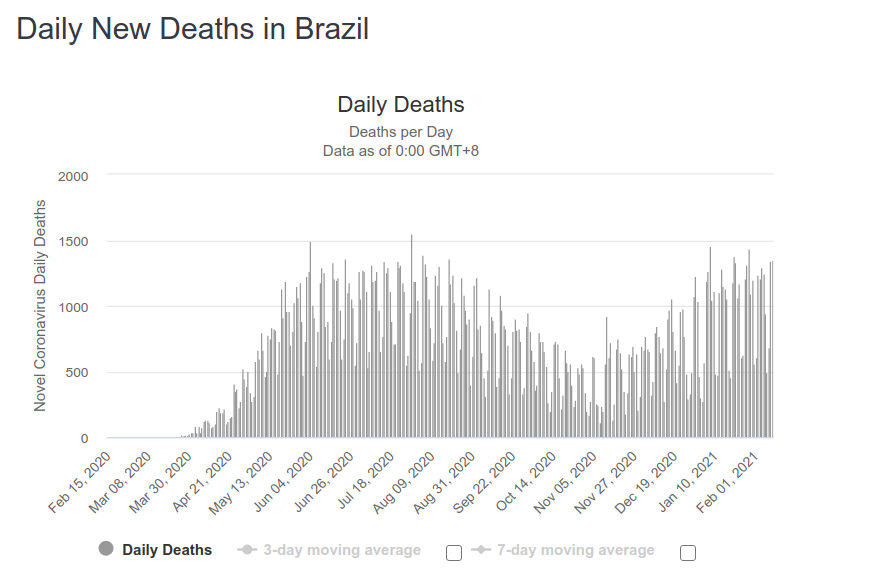by Glen Bishop

How likely is it, that there is going to be a summer surge in SARS-CoV-2, a surge where hospitals have similar numbers of coronavirus admissions to what they saw in January? Pretty unlikely, I would have guessed. But doing the rounds in the news was a paper by the Imperial College modelling team projecting just that. It predicts, as a mid-range scenario, 130,000 more deaths, with a catastrophic summer surge even if restrictions are lifted at the current snail’s pace and the vaccination programme goes well, at two million doses per week from February.
As a maths student at Nottingham University, I have been reading through some of the modelling done for SAGE recently. Bad modelling at the beginning of a pandemic, particularly with a communist country withholding or obscuring crucial data, is understandable. What I did not understand was how predictions of scenarios worse than have occurred anywhere in the world keep being predicted for the UK.
On reading the paper, I realised they are assuming there is absolutely no seasonality to SARS-CoV-2. This is fundamentally wrong. They are attributing all the reduction in R-value last spring to non-pharmaceutical interventions (NPIs) and none to seasonality, leading to assumptions that the base R-value in July will be the same as it was in January. This seemed crazy. It goes against the last century of knowledge on respiratory diseases and human coronaviruses. It also goes against the patterns shown in the real-world data from the last 12 months, in both the southern hemisphere and the northern hemisphere.
I emailed the Imperial researchers to verify that I wasn’t mistaken, and this was the assumption, and if so to find their justification for it. It was indeed the case and I received this paper as justification.
Now the first problem with that paper is that it was published in August, so all the data from the last six months, which I think anyone would agree shows significant seasonality, has not been included. In the moving picture of a pandemic, this is old science. Secondly, it seems more of a political commentary on the consequences of what the virus being seasonal would mean for American politics, rather than a purely scientific paper. It cautions the reader to look out for “bad faith politics”, the example it gives being “economic interests driving reopening or non-intervention”. Comments asserting that people wanting to address the fact that people are losing their livelihoods are engaging in “bad faith politics” have no place in an objective scientific paper. The paper also unfavourably includes comments by the President of Brazil and President Trump, as they mentioned seasonality could help reduce viral spread come summer. One ought not to be able to guess a scientist’s political leanings from a paper they write. It seems in some way that this paper was written as a political reaction to Trump mentioning something his advisers will have told him about seasonality.
The Imperial team would need to explain the following case study if they are to rationally ignore seasonality in their models. It shows the trajectories of coronavirus in Peru, Brazil, Sweden, and the UK. Observe the graphs of deaths for each country below. Two of these countries locked down heavily for a long period of time at the beginning of the epidemic, starting in March. Two opted for predominantly voluntary measures, refusing to use significant NPIs and schools carrying on as usual. Two are at the same level in the northern hemisphere, two are 70 degrees of latitude to the south, in the southern hemisphere. If the Imperial teams’ assumption is correct, then the pattern of deaths between the countries should be along the lines of NPIs and their severity. This is clearly not the case.




The Graphs of Sweden and the UK share a distribution of deaths over the year. As do the graphs of Peru and Brazil. Yet the UK and Peru shared similar NPIs, both locking down harshly. The UK lockdown was enforced by police allowing only one exercise outing per day, with all schools closed. The Peruvian experience was enforced by the military and did not even allow men and women to leave the house for shopping on the same days.
Brazil and Sweden both had fewer restrictions, though they were both a more mixed picture, with Brazil enduring differing levels of restrictions at different times in different states and Swedish people voluntarily changing their habits to reduce social contact at high rates. So, if there is no seasonality, what explains this? Every European country, irrespective of NPIs introduced, follows the same pattern: minimal spread in summer followed by a surge in autumn and winter. Canada shows the same pattern, as do the northern states in the US. South Dakota never locked down and had barely any spread until autumn came around, when suddenly cases surged. There was no change in NPIs causing that, it was seasonality.
I must add a caveat; in a new pandemic, if the virus is infectious enough, then a high R-value will conceal the effects of seasonality until a significant enough amount of immunity is reached. This is evidently not the case with this virus in Europe, as the patterns were clear in summer and far more immunity has been built up since then, even without the vaccine.
As I raised the difference between the UK and Peru. I’ll quickly comment on another Imperial paper with problems. This paper, published in December 2020, exclaims that first wave deaths in the UK could have been more than halved, had lockdown been brought in a week earlier. Peru, whilst having fewer cases than the UK, started their lockdown over one week earlier than the UK did, enforced it more tightly, and kept it going for longer. I would suggest the lockdown in Peru did not cause deaths to drop quickly like they did in the UK because Peru was entering their epidemic season, which is between May and October. If the Imperial team is assuming no seasonality, why would one-week earlier work in the UK, when 10 days earlier did not work in Peru? The cognitive dissonance shown by SAGE in respect of the international data is shocking.
Given all the data over the last year from all over the world, in countries using different sets of NPIs, and all the historical publications on seasonal viral infections and human coronaviruses (such as this one), it seems to me that the Imperial model is built on a foundation which is completely wrong. It is misattributing a reduction in the R-value last spring to their own policy recommendations and so massively overestimating the effectiveness of NPIs and failing to spot the large effect of seasonality. This leads not just to projections of deaths being too high, but an over-estimate of how much the NPIs can reduce the deaths that would have occurred. This is likely why their suggestions disagree with many published papers, showing little to no correlation between lockdown and mortality, such as this one which concludes: “Rapid border closures, full lockdowns, and wide-spread testing were not associated with COVID-19 mortality per million people”.
The decrease in spring seems to be acting as confirmation bias for many of the scientists modelling the epidemic. Would they be so sure of lockdown efficacy if they were working in Peru and had to watch cases increase for months after introducing the lockdowns, rather than watching the lockdowns act alongside the seasonality as they did in Europe? Lockdowns certainly will reduce social contact and, likely, the R-rate to some degree, but not as much as the Imperial team believes.
The Imperial college model is a thing of mathematical beauty. It is intricate and complex enough that no mere MP would dare try to question the details of it. But no matter how good a scientific model looks, and how hard the theory and coding behind it is to grasp, if the fundamental assumptions are wrong it will not work. When Einstein simplified general relativity, he is quoted as saying: “everything should be as simple as possible, but no simpler”. The above is a simple analysis of the data over the last 12 months from an undergraduate maths student. If Professor Ferguson wants to wager whether there will be a significant surge of coronavirus fatalities between June and September this year, I will happily put all the student loan I have saved in lockdown on him being wrong.
MPs all seem to acknowledge that there is seasonality in the virus, as do Professors Whitty and Vallance when giving briefings. I write this article because my emails trying to make MPs and scientists aware of these bad modelling assumptions got some traction. I contacted well known professors, including signatories of the Great Barrington Declaration, who each took the time to read the points I was making and escalated it where they could, to make sure MPs are made aware before using these models to shape policy going forwards. Science works best when students are encouraged to question professors. You’ll always be able to find good professors willing to give time to listen to a student questioning scientific orthodoxy. Hopefully, the cogs are in motion and MPs will realise they are being given predictions based on assumptions they themselves disagree with.
In 1961 psychologist Stanley Milgram studied the effect of authority figures on people’s judgement. He told the participants they had to administer electric shocks to a ‘learner’ (an actor they believed to be a fellow participant). When the learner did not answer correctly, Milgram told the ‘teachers’ to shock the ‘learner’, unaware they were the real subject of the experiment. As the fake voltage was increased, the actor would make audible protests and demand to be let out, banging on the wall separating them from the ‘teacher’. When the ‘teachers’ asked to stop the experiment, believing they were harming the actor, they were given simple verbal prods, such as ‘please continue’ and ‘it is absolutely essential that you continue’, from Milgram, the authority figure, the man in the white lab coat. Despite verbally protesting, 66% of participants kept giving shocks to the point where, had they been real, the ‘learner’ would have been killed. Humans have evolved to place far too much trust in authority figures. Professor Whitty and Ferguson are telling Boris: “it is absolutely essential that you continue” to keep lockdown going for longer. Unfortunately, he is part of that 66%.
The human mind is extremely susceptible to bias and history is full of brilliant scientists making basic mistakes, particularly when put in the public spotlight and under pressure. Politicians need to treat scientists like humans, not gods.











Donate
We depend on your donations to keep this site going. Please give what you can.
Donate TodayComment on this Article
You’ll need to set up an account to comment if you don’t already have one. We ask for a minimum donation of £5 if you'd like to make a comment or post in our Forums.
Sign UpLatest News
Next PostLatest News